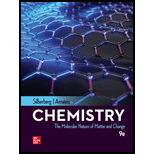
Concept explainers
(a)
Interpretation:
The bonds in
Concept introduction:
An ionic bond is formed by the interaction of a metal with a non-metal. A polar covalent bond is formed by sharing of electrons between nonmetals of different electronegativity while the nonpolar covalent bond is formed by sharing of electrons between nonmetals of similar electronegativity.
(b)
Interpretation:
The bonds in
Concept introduction:
An ionic bond is formed by the interaction of a metal with a non-metal. A polar covalent bond is formed by sharing of electrons between nonmetals of different electronegativity while the nonpolar covalent bond is formed by sharing of electrons between nonmetals of similar electronegativity.
(c)
Interpretation:
The bonds in
Concept introduction:
An ionic bond is formed by the interaction of a metal with a non-metal. A polar covalent bond is formed by sharing of electrons between nonmetals of different electronegativity while the nonpolar covalent bond is formed by sharing of electrons between nonmetals of similar electronegativity.
(d)
Interpretation:
The bonds in
Concept introduction:
An ionic bond is formed by the interaction of a metal with a non-metal. A polar covalent bond is formed by sharing of electrons between nonmetals of different electronegativity while the nonpolar covalent bond is formed by sharing of electrons between nonmetals of similar electronegativity.
(e)
Interpretation:
The bonds in
Concept introduction:
An ionic bond is formed by the interaction of a metal with a non-metal. A polar covalent bond is formed by sharing of electrons between nonmetals of different electronegativity while the nonpolar covalent bond is formed by sharing of electrons between nonmetals of similar electronegativity.
(f)
Interpretation:
The bonds in
Concept introduction:
An ionic bond is formed by the interaction of a metal with a non-metal. A polar covalent bond is formed by sharing of electrons between nonmetals of different electronegativity while the nonpolar covalent bond is formed by sharing of electrons between nonmetals of similar electronegativity.
Interpretation:
The order of increasing bond polarity among the following compound is to be determined.
Concept introduction:
An ionic bond is formed by the interaction of a metal with a non-metal. A polar covalent bond is formed by sharing of electrons between nonmetals of different electronegativity while the nonpolar covalent bond is formed by sharing of electrons between nonmetals of similar electronegativity.
Want to see the full answer?
Check out a sample textbook solution
Chapter 9 Solutions
CHEMISTRY:MOLECULAR...(LL)-W/CONNECT
- Don't used hand raitingarrow_forwardCHEM2323 Problem 2-24 Tt O e: ל Predict the product(s) of the following acid/base reactions. Draw curved arrows to show the formation and breaking of bonds. If the bonds needed are not drawn out, you should redraw them. + BF3 (a) (b) HI + (c) OH -BF Problem 2-25 Use curved arrows and a proton (H+) to draw the protonated form of the following Lewis bases. Before starting, add all missing lone pairs. (a) (b) :0: (c) N 1 CHEM2323 PS CH02 Name:arrow_forwardCHEM2323 Problem 2-26 Tt O PS CH02 Name: Use the curved-arrow formalism to show how the electrons flow in the resonance form on the left to give the one on the right. (Draw all lone pairs first) (a) NH2 NH2 + (b) Problem 2-27 Double bonds can also act like Lewis bases, sharing their electrons with Lewis acids. Use curved arrows to show how each of the following double bonds will react with H-Cl and draw the resulting carbocation. (a) H2C=CH2 (b) (c) Problem 2-28 Identify the most electronegative element in each of the following molecules: (a) CH2FCI F Problem 2-29 (b) FCH2CH2CH2Br (c) HOCH2CH2NH2 (d) CH3OCH2Li F 0 0 Use the electronegativity table in Figure 2.3 to predict which bond in the following pairs is more polar and indicate the direction of bond polarity for each compound. (a) H3C-Cl or Cl-CI (b) H3C-H or H-CI (c) HO-CH3 or (CH3)3Si-CH3 (d) H3C-Li or Li-OHarrow_forward
- Reagan is doing an atomic absorption experiment that requires a set of zinc standards in the 0.4-1.6 ppm range. A 1000 ppm Zn solution was prepared by dissolving the necessary amount of solid Zn(NO3)2 in water. The standards can be prepared by diluting the 1000 ppm Zn solution. Table 1 shows one possible set of serial dilutions (stepwise dilution of a solution) that Reagan could perform to make the necessary standards. Solution A was prepared by diluting 5.00 ml of the 1000 ppm Zn standard to 50.00 ml. Solutions C-E are called "calibration standards" because they will be used to calibrate the atomic absorption spectrometer. a. Compare the solution concentrations expressed as ppm Zn and ppm Zn(NO3)2. Compare the concentrations expressed as M Zn and M Zn(NO3)2 - Which units allow easy conversion between chemical species (e.g. Zn and Zn(NO3)2)? - Which units express concentrations in numbers with easily expressed magnitudes? - Suppose you have an analyte for which you don't know the molar…arrow_forwardNonearrow_forwardHow will you prepare the following buffers? 2.5 L of 1.5M buffer, pH = 10.5 from NH4Cl and NH3arrow_forward
 ChemistryChemistryISBN:9781305957404Author:Steven S. Zumdahl, Susan A. Zumdahl, Donald J. DeCostePublisher:Cengage Learning
ChemistryChemistryISBN:9781305957404Author:Steven S. Zumdahl, Susan A. Zumdahl, Donald J. DeCostePublisher:Cengage Learning ChemistryChemistryISBN:9781259911156Author:Raymond Chang Dr., Jason Overby ProfessorPublisher:McGraw-Hill Education
ChemistryChemistryISBN:9781259911156Author:Raymond Chang Dr., Jason Overby ProfessorPublisher:McGraw-Hill Education Principles of Instrumental AnalysisChemistryISBN:9781305577213Author:Douglas A. Skoog, F. James Holler, Stanley R. CrouchPublisher:Cengage Learning
Principles of Instrumental AnalysisChemistryISBN:9781305577213Author:Douglas A. Skoog, F. James Holler, Stanley R. CrouchPublisher:Cengage Learning Organic ChemistryChemistryISBN:9780078021558Author:Janice Gorzynski Smith Dr.Publisher:McGraw-Hill Education
Organic ChemistryChemistryISBN:9780078021558Author:Janice Gorzynski Smith Dr.Publisher:McGraw-Hill Education Chemistry: Principles and ReactionsChemistryISBN:9781305079373Author:William L. Masterton, Cecile N. HurleyPublisher:Cengage Learning
Chemistry: Principles and ReactionsChemistryISBN:9781305079373Author:William L. Masterton, Cecile N. HurleyPublisher:Cengage Learning Elementary Principles of Chemical Processes, Bind...ChemistryISBN:9781118431221Author:Richard M. Felder, Ronald W. Rousseau, Lisa G. BullardPublisher:WILEY
Elementary Principles of Chemical Processes, Bind...ChemistryISBN:9781118431221Author:Richard M. Felder, Ronald W. Rousseau, Lisa G. BullardPublisher:WILEY





